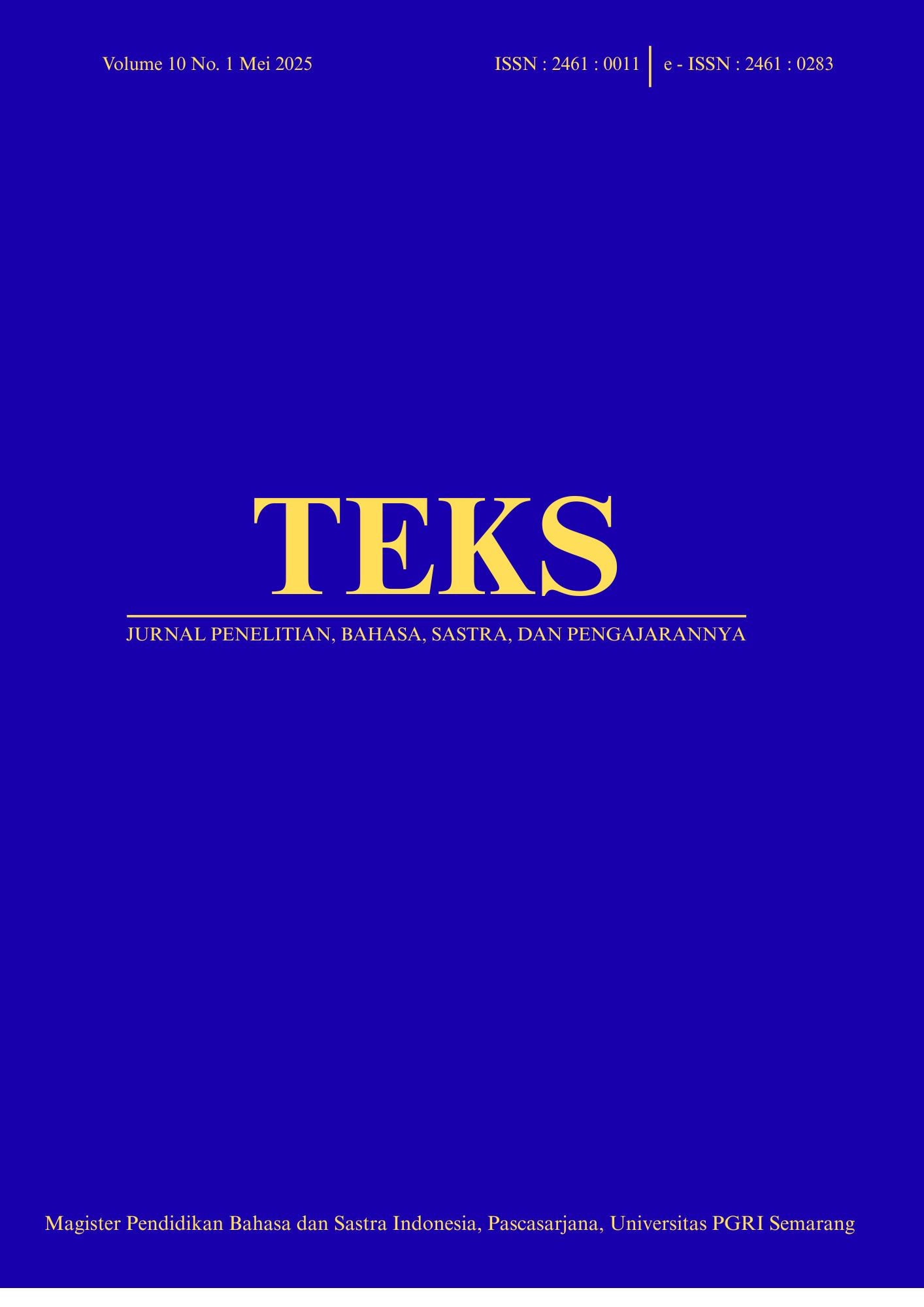FRAGMENTARY AESTHETICS AND LYRICISM IN APITO LAHIRE’S POETRY
DOI:
https://doi.org/10.26877/teks.v9i1.2577Keywords:
bahasa liris, estetika fragmentaris, puisi cinta, stilistika, fragmentary aesthetics, love poetry, lyrical language, stylisticsAbstract
Apito Lahire’s poems offer a unique fusion between fragmentary aesthetics and lyrical language. This study examines the works of the poet from Tegal, Central Java, published in Buletin Kelelawar #2 (January 2010) under the title “Sekarang Menulis, Besok Tidur” (“Writing Now, Sleeping Tomorrow”), with the aim of revealing how fragmentary aesthetics and lyricism are manifested in four of his poems: “Filsafat Cinta” (Philosophy of Love), “surat kesembilan hanya buat nyinyik” (the ninth letter only for Nyinyik), “surat kesepuluh, nyinyik” (the tenth letter, Nyinyik), and “surat keenambelas bagi nyinyik” (the sixteenth letter for Nyinyik). These poems attempt to present fragmented poetic idioms—disjointed and partial structures that can be referred to as fragmentary constructs—while at the same time preserving emotional intensity through expressive and powerful lyrical language. This research employed a descriptive-qualitative method with stylistic and semiotic approaches to examine the linguistic structures, rhetorical styles, and symbolic meanings that emerge in the poems. The findings show that Apito Lahire’s poetry offers an interplay between fragmentary aesthetics and lyricism. Fragmentary aesthetics are characterized by seemingly broken and repetitive utterances with conversational tones, while lyricism emerges through emotional intensity, repetitions of love expressions, and prayers that evoke spiritual nuances. Thus, Apito Lahire’s poetry demonstrates that poetics do not always manifest in purely linear and coherent forms, but can also be expressed through fragments of language deliberately constructed to create reflective and emotional spaces. The findings of this study affirm that Apito Lahire’s works contribute to enriching the landscape of contemporary Indonesian poetry through aesthetic strategies that diverge from common tendencies. Apito Lahire does not merely present poetry as a medium of personal expression, but also as a space for formal experimentation that challenges the way readers comprehend poetic texts. The fragmentary aesthetics he employs do not necessarily render his poetry difficult to understand; rather, they open up possibilities for multilayered interpretations, while the underlying lyrical language offers emotional depth capable of touching the reader’s inner experience. Thus, Apito Lahire’s works are not only significant within the framework of stylistic and semiotic studies but also within the broader context of literary aesthetics, as they provide new insights into how poetry can continually transform in response to the dynamics of time without losing its reflective and spiritual power.
References
Andrian, S. N. (2017). Remang-Remang Kontemplasi. Yogyakarta: Garudhawaca.
Andrian, S. N. (2018). Sarana Retorika dalam Buku Puisi Ibu, Aku Minta Dibelikan Mushola karya Andy Sri Wahyudi. Seminar Nasional Bulan Bahasa 1 “Menduniakan Bahasa dan Sastra Indonesia” Fakultas Pendidikan Bahasa dan Seni, Universitas PGRI Semarang, 7 November 2018, Halaman 208-218.
Andrian, S. N. (2024). Godaan dari Dalam. Kendal: Lembaga Pelatihan Kerja Sangkar Arah.
Andrian, S. N., Ripai, A. (2024). Puisi Era Kecerdasan Buatan. Proceedings Series on Social Sciences & Humanities, Volume 20, Prosiding Pertemuan Ilmiah Bahasa & Sastra Indonesia (PIBSI XLVI), Universitas Muhammadiyah Purwokerto. 10.30595/pssh.v20i.1392.
Gilbert, H., & Tompkins, J. (1996). Post-colonial Drama: Theory, Practice, Politics. London & New York: Routledge.
Hunt, P. (2009). Understanding children’s literature (2nd ed.). London & New York: Routledge.
Morris, R. C. (2010). Can the subaltern speak? Reflections on the history of an idea. New York: Columbia University Press.
Nikolajeva, M. (2014). Reading for learning: Cognitive approaches to children’s literature. Amsterdam & Philadelphia: John Benjamins Publishing Company.
Lahire, A. (2010). Buletin Sastra Lembah Kelelawar Edisi #2 (Januari, 2010). Semarang: Komunitas Sastra Lembah Kelelawar.
Lickona, T. (1992). Educating for character: How Our Schools Can Teach Respect and Responsibility. Bantam Books.
Pradopo, R. D. (2007). Pengkajian Puisi. Yogyakarta: Gadjah Mada University Press.
Ratna, N. K. (2013). Teori, Metode, dan Teknik Penelitian Sastra. Yogyakarta: Pustaka Pelajar.
Semi, M. A. (1993). Metode Penelitian Sastra. Bandung: Angkasa.
Turahmat; Andrian, S. N.; Rachman, D. (2024). Prophetic Literary Ethics in the Book of Poetry When Grass Meets God by Ahmadun Yosi Herfanda. Teks: Jurnal Penelitian Bahasa, Sastra, dan Pengajarannya, 18(2), 153–160. 10.5430/wjel.v14n3p220.






